French
Volunteer Legion Awards
|
Légion
des Volontaires Français
Below is an interesting picture showing French Legionnaires departing to the Eastern Front. All of them wearing their distinctive beret. Next to it is the oficial French National shield BeVo pattern instituted in July 1941.
|
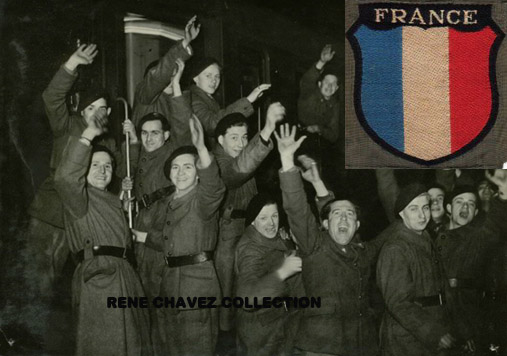
French Volunteer Legion
|
|
Parti Populaire Français

Shown is the scarce enameled Parti Populaire Français lapel button badge.
The Parti Populaire Français (French
Popular Party) was a French fascist and anti-semitic political party led by Jacques Doriot before and during
World War II.
Doriot who was initially a member of the French Communist party was expelled in 1934 from the
Communist Party. Bitter towards the Comintern, his views turned to embrace the French nation, evolving into
a National Socialism. In June 28, 1936, Doriot and a number of former members of the French
Communist Party formed the Parti Populaire Français. Doriot and his supporters were vocal advocates of
France becoming organized along the lines of Fascist Italy and Nazi Germany. Doriot became a staunch pro-
German and supported Germany's occupation of northern France in 1940, specifically due to Hitler's anti-
Bolshevik policy. In 1941, he and fellow fascist collaborator Marcel Déat founded the Légion des
Volontaires Français (LVF), a French unit of the Wehrmacht.
During the war Doriot fought personally in German uniform on the Eastern Front, with the rank of lieutenant
and was awarded the Iron Cross in 1943. In his absence leadership of the PPF officially passed to a
directorate, although real power came to lie with Maurice-Yvan Sicard. Doriot was killed on 22 February 1945
while traveling from Mainau to Sigmaringen when his car was strafed by Allied fighter planes.
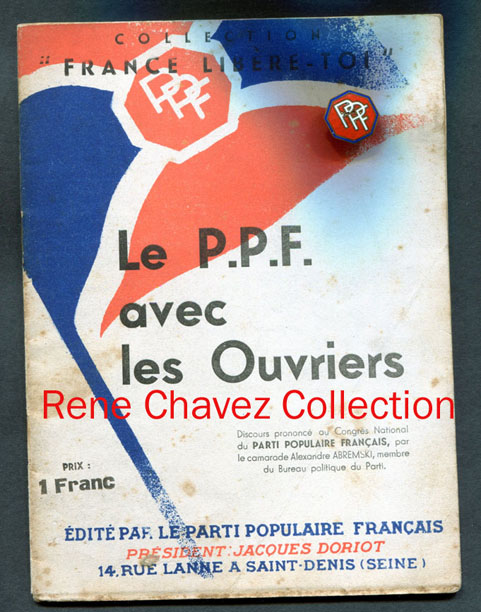 Above is a booklet of the PPF and the lapel button worn by members of the party.
Above is a booklet of the PPF and the lapel button worn by members of the party.
|
|
French Volunteer Legion and Vichy Awards
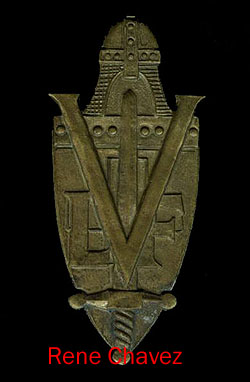
Interesting metal LVF badge worn on both collars and as a beret badge (with French uniform only). This device is a shield surmounted by a Norman helmet with upward pointing sword and the L.V.F. abbreviation.
Many
Frenchmen that served with the Germans were awarded with German military decorations and
military decorations sanction by the Vichy Government.
French Legionnaires were also allowed to wear their awards and decorations on German uniforms.
|
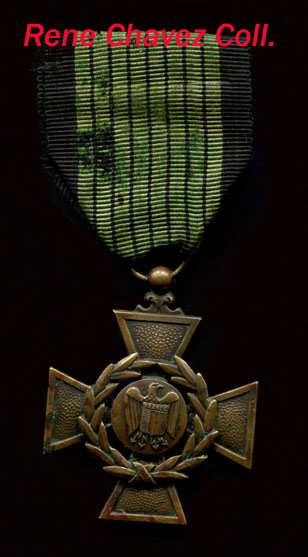

Croix de Guerre Légionnaire
The "Croix de Guerre Légionnaire" (War Cross Legionnaire) or often known
improperly by the collecting circles as the "Légion des Voluntaires
Français" (LVF) Cross was a decoration originally intended to be awarded to
members of the "Légion Tricolore" (Tricolor Legion).
This extremely rare Vichy Award was instituted in July 6, 1942, however, it was officially Decree
(Article 4) by the head of the Vichy government on 16 September 1942, in recognition for
the heroic military contribution of the French Volunteer Legion, Tricolore Legion and
Phalange Africane.
According to Robert Forbes excellent book "Pour L'Europe" the award
was officially recognized by the Vichy Government on 18 July 1942.
This war cross was privately commissioned and produced by the firm "Monnaie de Paris"
(Paris Mint), although recognized by the Vichy government it was not an official
award
The Cross is formed from parts of the overall 1939
"Croix de Guerre" model and measures 38.0mm. The swords were removed and substituted by
a stylized laurel crown 25mm outer diameter that is linked in the bottom. Each side of the
crown is made of 12 leaves and is die stamped. The center medallion piece was
replaced by another medallion piece 14mm in diameter that shows an emblem of the
French Tricolore. It shows the Vichy style eagle with a shield in the center
holding four flashes.
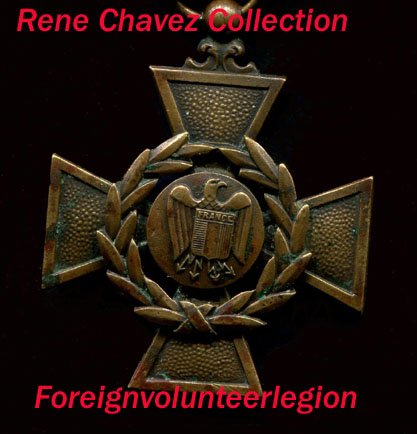
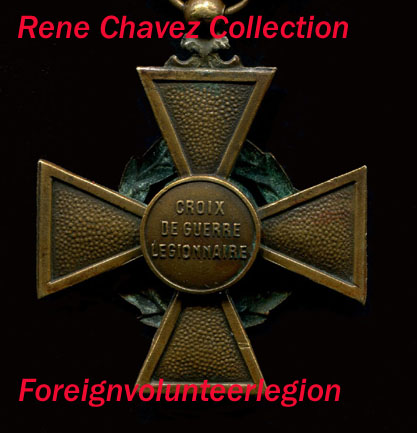
The reverse of the circular piece contains the inscription
"CROIX/DE GUERRE/LEGIONNAIRE." The color of the war cross is light color bronze.
Some of these LVF crosses have been found with markings. These markings are shown on
one of the sides of the cross legs and has a hand stamped in-print. The marking normally will
have a cornucopia style horn followed by either the letters "BR" or "BP."

The medal is held by a green ribbon of 37.5mm width showing on each side a wide vertical
black edges with seven vertical black stripes.
The cross was awarded to individuals of
any rank who distinguished themselves by heroism in combat against enemy forces and also to
anyone mentioned in dispatches for bravery in action. Citations were conferred for subsequent
acts of bravery. Recipients earned stars and palms for regimental, division, corp or army levels.
The stars and palms were attached on the ribbon.
This cross has been erroneously attributed to the firm "Arthus-Bertrand."
It is estimated that about 400 "Croix de Guerre Légionnaire" crosses were awarded.
To find out more about the LVF Croix please read my article relating to the "Croix de Guerre Légionnaire" published in the December 2014 of the International Militaria Collector Magazine.
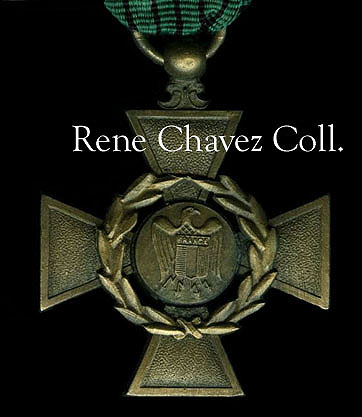
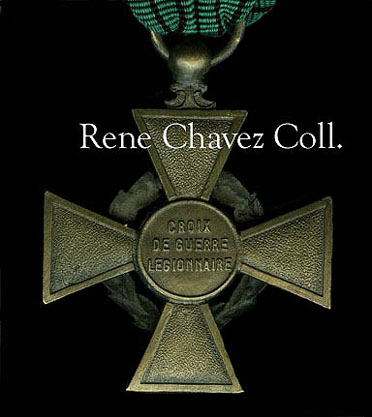
Of interest there are other versions of the cross that were made but nobody knows if they are
pre-war or post-war. Above is one of those versions quite differently from the official
cross. Notice that the center medallion piece shows the Vichy eagle, which is quite different
from the original one.
Considering the rarity of the war cross numerous forgeries have been made.
This cross obviously became prohibited after the war ended and was removed
in accordance with the Decree of 7 January 1944.
Croix de guerre
de l´État français 1944
The Croix de Guerre Etat Francaise 1944 was probably instituted in early in 1944, by the
Pétain government and was a purely military award, therefore members of the Milice and
other paramilitary and security organizations were ineligible. By that stage, the only soldiers that
could be eligible for this award were members of Pétain´s personal bodyguard and
the "1er régiment d´infanterie de France" a purely Vichy unit raised in
1943. The 1944 Vichy war cross was awarded for heroic deeds in combat against partisans of
various resistance groups and their SAS and SOE comrades.
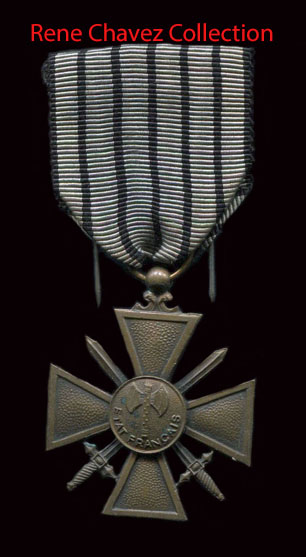
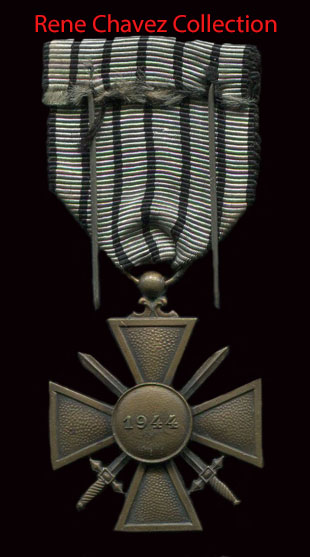 The cross was made by the firm La Monnaie de Paris. Unlike the Croix de Guerre
Légionnaire the swords remain in place. The obverse has a medallion attached in the center
and shows the double bladed axe Vichy symbol "Francisque" and below the scripted
legend "ETAT FRANCAIS," the reverse has the date "1944."
The cross was made by the firm La Monnaie de Paris. Unlike the Croix de Guerre
Légionnaire the swords remain in place. The obverse has a medallion attached in the center
and shows the double bladed axe Vichy symbol "Francisque" and below the scripted
legend "ETAT FRANCAIS," the reverse has the date "1944."
Since these
crosses were issued in 1944, they should have the 2nd type green ribbon with the vertical black
stripes. The example shown has the first type grey ribbon with five vertical black stripes.
It is estimated in the collector community that no more than 200 Croix de Guerre Etat Francaise 1944
were produced, perhaps far less, were awarded before the collapse of the Vichy regime in August
1944, making this cross as rare as or perhaps even rarer than the fabled Croix de Guerre
Légionnaire.
Francisque
Gallique
The "Francisque Gallique"
was the highest Vichy national award equivalent to the "Legion de Honor." The
award was instituted on 26 May 1941 and was rendered for the following reasons:
1. to those persons who had participated in actions before the war, which conformed
to the Principles of the National Revolution.
2. to those who have shown since
the war an active attachment to the person and work of the Marshal.
3. and to
those who have performed brilliant deeds of military or civic service.
The Francisque Gallique is a small enameled badge measuring 24mm x 21mm.
The reverse of the badge shows the marking "A. AUGIS-28-M TEE SI BARTHELEMY-LYON."
It should be noted that these badges were never numbered.
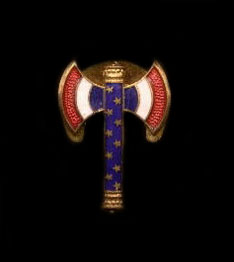
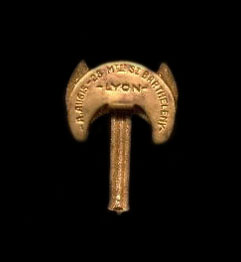 Francisque Gallique
Francisque Gallique
|
|
French servicemen who had won the
"Croix de Guerre"and the
"Croix du Combattant"
in the
1939-1940 war with Germany before the armistice of June 22, 1940, and who choose to serve
in the French armed forces under the Vichy regime had to exchange their
Republican awards for the Vichy versions.
Vichy Croix de Guerre
Vichy Croix
de Guerre, 1939/40: French veterans who had received the "Croix de Guerre" (War
Cross) under the French government before the German invasion had to return their
decorations in exchange for the new Vichy War Cross. This depended of course on
each individual case.
 The Vichy version War Cross was instituted on 28 March 1941. The War Cross has the same designed as the 1939 type with the exception that the reverse of the center medallion piece shows the 1939/1940 inscription. A new ribbon was made, green with black edges and five black stripes (similar to the 1914/18, type ribbon with black stripes replacing the red). Three other versions of the Vichy War Cross was designed and made; however, none have been documented. The War Cross shown on the left side was produced by the firm "Monnaie de Paris" (Paris Mint). The ribbon has a silver star for those who had been mentioned at division level. The cross came with a rare green color thin cardboard case as shown in the center. The right side shows an unofficial cross notice the difference in the medallions. The ribbon has a bronze palm leaf for those who had been mentioned at the army level.
The Vichy version War Cross was instituted on 28 March 1941. The War Cross has the same designed as the 1939 type with the exception that the reverse of the center medallion piece shows the 1939/1940 inscription. A new ribbon was made, green with black edges and five black stripes (similar to the 1914/18, type ribbon with black stripes replacing the red). Three other versions of the Vichy War Cross was designed and made; however, none have been documented. The War Cross shown on the left side was produced by the firm "Monnaie de Paris" (Paris Mint). The ribbon has a silver star for those who had been mentioned at division level. The cross came with a rare green color thin cardboard case as shown in the center. The right side shows an unofficial cross notice the difference in the medallions. The ribbon has a bronze palm leaf for those who had been mentioned at the army level.
 Above shows the reverse illustrating the different date sizes between both crosses.
This image shows on the right side the "Monnaie de Paris" (Paris Mint) cross.
Above shows the reverse illustrating the different date sizes between both crosses.
This image shows on the right side the "Monnaie de Paris" (Paris Mint) cross.
This cross also became prohibited after the war ended and was removed in
accordance with the Decree of 7 January 1944.
|
La Croix du Combattant de la Guerre 1939-1940
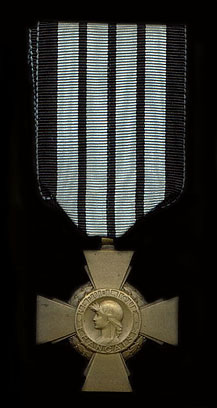
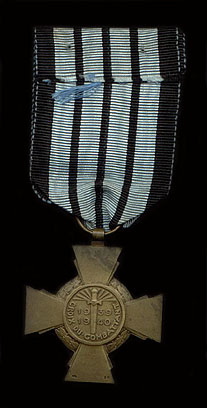
This cross was created by the Vichy government on March 28, 1941. It has the same designed as the 1939 type with the exception that on the reverse of the center medallion piece shows the
1939/1940 inscription.
In addition A new ribbon was made, light blue color with black edges and three
narrow black stripes.
The original combatants war cross of "1939-1945" was restored accordance with the Decree of 29 January 1948.
|
|
The Vichy 1941 Commemorative Levant Medal
The Levant medal was issued by the French government in 1922 to award those who participated in the battles that erupted in the Middle East in the immediate aftermath of World War1 between France and the local powers.
On January 1920 the French forces engaged against Syria in the so-called Franco-Syrian War. This campaign ended when the French troops entered and occupied Damascus on July 24, 1920. However, Turkey also engaged the French colonial forces, which lasted from May 1920 to October 1921, resulting in a partial French occupation of Turkish soil.
General Castelnau proposed to the Chamber of Deputies to create a commemorative medal. The Syria-Cilicia commemorative medal was instituted by the law of 18 July 1922.
The Syria-Cilicia commemorative medal was bestowed to soldiers and sailors, members of the Army of the Levant or of naval forces that operated off the coast of Syria-Cilicia, between 11 November 1918 and 20 October 1921; to members of the military having taken part in the operations carried out between 21 July 1925 and 30 September 1926; to civilian personnel of French nationality, fulfilling the same prerequisites as soldiers or sailors in earning this award.
|


The Vichy Commemorative Levant 1941 Medal
During World War 2 Vichy sponsored and produced an identical medal to recognize engagements fought by its forces in the same area from 8 June to 12 July 1941, it was adorned with the clasp "LEVANT 1941."
Interestingly most of the battles were between the Vichy forces and the Free French forces. This was and still is a source of national pain for France. Consequently, a law of 12 April 1944 abolished this medal and the right to wear it.
Above is an official French Syria-Cicilia commemorative medal issued in 1922. The obverse bears the relief image of the "Warrior Republic" in the form of the left profile of a helmeted woman's bust, the helmet being adorned by a crown of oak leaves. On either side, the relief inscription along the circumference "RÉPUBLIQUE FRANÇAISE" (French Republic).
The reverse, representing both the army and navy, bears the relief images of an infantry rifle crossed with a naval anchor below two military banners and lances surmounted by the relief inscription "LEVANT. " Some of the variants, have on the banners the relief inscription is "HONNEUR ET PATRIE - SYRIE-CILICIE" (Honor and Country - Syria Cilicia) or only "HONNEUR ET PATRIE." In the background, sand dunes, the wall of a Kasbah and palm trees.
The ribbon shows two clasps with oriental ornamentation. The first bearing a silver color clasp with the inscription "LEVANT 1941." The second clasp is bronze color and has the inscription "LEVANT" issued for participations in the operations between 11 November 1918 and 20 October 1921. The manufacturing was exclusively reserved for "Monnaie de Paris" (Paris Mint). However, there is a variant of a diameter size of 36 mm made by the firm "Arthus-Bertrand. "
|
La Milice Français
The Milice Français was formed in December 1942; this security force was loyal to the Vichy
Government and dealt with all matters relating to the Communist and Resistance groups or internal
threat.
The Milice was divided into three main groups:
(1) The Franc-Garde
(2) Les Miliciennes (Women's Section)
(3) Avant-Garde Milicienne (Youth Branch)
The uniform of the Milice was a dark blue tunic, dark blue beret, khaki shirt, black tie and dark blue pants.
The emblem is a stylized gamma in a circle., the symbol represented the power and energy of a reborn France.
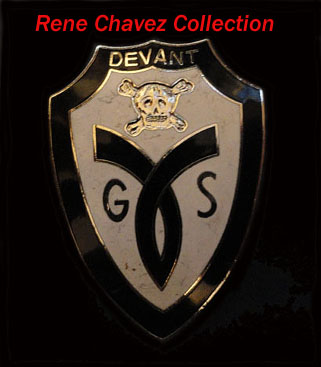
The breast badge shown was worn by the Groupe Spécial de Sécurité, which was created in
1943. The Milice emblem is enameled and has a black bordered edge with a white shield center. In the center it
has a silver death's head, black gamma, and "G.S." surmounted by the silver inscription "Devant." It was made
by the Paris firm "DuFrene."
[Front
Page] [Top ][Previous
Page] [Next Page]
|
|
|





















